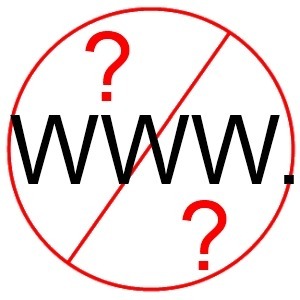0 notes &
Does your website need the “www” to work?

Andy, my partner and occasional blogger, began a little project recently that enabled him to capture a list of domain names. As part of this project, he also tested if the sites responded correctly with and without the “www.” prefix (sometimes called “the dubs”). You might be surprised by the results.
So far the list of Australian domains (ending in “.com.au”) has reached just over 50,000. Of that list, just under 1000 (991 at time this article was prepared) failed to load correctly when “www.”. That represents about 1.7% of the domains he tested.
[Update 28 Aug 2013: We now have 96,581 “.com.au” domains tested and the percentage has risen to 1.98%. As concerning as that number is, of all the domains we’ve tested, not just the “.com.au”, the percentage is even higher - 3.98%.]
[Update 27 November 2013: 392,795 is the current count of “.com.au” domains. The percentage of domains requiring the “www.” prefix has fallen to 1.47% but the implications if you are in this group remain unchanged.
I have no idea of the total number of “.com.au” domains and therefore don’t know if our sample is statistically significant. But if your domain is in the 1.7%, it is significant to you.
What are the implications?
I cannot predict all the circumstances under which someone will attempt to visit your page using the shorter version of the domain name. Here are some of the circumstances I can think of ..
- lazy typist entering the domain directly into their browser (4 keystroke saving - that’s me)
- a link from a remote site where the prefix is not included (you have no way to control how those links are formed)
- domain name spoken to a potential visitor (the prefix is just a few syllables too many and everyone knows to add it anyway)
- you have a long domain name and it’s a struggle to fit it on your business card or the side of your truck (something has to give)
- Google doesn’t show the prefix for some reason
In any of these circumstances, the visitor will not see your website and won’t know why. Some will try adding the prefix but many won’t. They will assume the link is wrong or the website is off-the-air. They may try again later or they might go to Google to find a website that works. Unless they work out the prefix is the problem, it is unlikely they will ever visit your website. Opportunity lost.
How to fix it?
Unfortunately, there’s no simple answer to the question. It has to do with the way your domain is defined at your hosting company. If you have a direct relationship with the hosting provider raise a support ticket. If you have a webmaster to take care of all that stuff for you, then call him / her and ask for it to be fixed.
First task is to test if you are in the 1.7%. Don’t get anyone else to do. Do it yourself. Enter your domain name without the “www.” prefix directly into the address bar of your browser, not in the search box of Google. If your website displays you are OK for now. If not talk to your hosting company or your web developer.
Anything else?
This discussion is different to the technical issue of should I or how do I redirect from no dubs to dubs (way too geeky for this post) or the discussion about the potential for duplicate content implications for being found with and without dubs (this is no longer a fight worth having). And it certainly isn’t a discussion about the aesthetics of showing the dubs or not or if the absence of dubs will confuse the less technically aware into not recognising the domain as a web address. All of those are valid discussion topics but for another day.
I suggest you test your website regularly (annually or if you change hosting company or registrar) to make sure all remains well. A number of other tests to be performed are outlined in some previous posts listed below.
Related articles:
- Checklist to protect your web presence (blog.midboh.com.au)
- WWW - Is it essential when typing the URL? (blog.midboh.com.au)
- Checklist to start the new year (blog.midboh.com.au)
photo credit: me